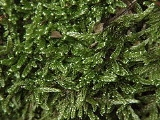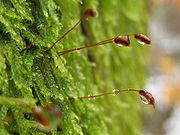
Hypnum cupressiforme
Encyclopedia
Hypnum cupressiforme is a common and widespread species
of moss
belonging to the genus
Hypnum. It is found in all continents except Antarctica and occurs in a wide variety of habitats and climatic zones. It typically grows on tree trunks, logs, walls, rocks and other surfaces. It prefers acid
ic environments and is fairly tolerant of pollution
. It was formerly used as a filling for pillows and mattresses; the association with sleep is the origin of the genus name Hypnum (from Greek
Hypnos
).
 It is a small to medium-sized moss about 2-10 cm long. It is pleurocarpous, having prostrate, creeping stems which form smooth, dense mats. The stems are branched and covered in overlapping leaves giving the impression of a cypress
It is a small to medium-sized moss about 2-10 cm long. It is pleurocarpous, having prostrate, creeping stems which form smooth, dense mats. The stems are branched and covered in overlapping leaves giving the impression of a cypress
tree. The stem leaves are long and thin measuring 1.0-2.1 mm by 0.3-0.6 mm. They are concave and sickle-shaped, tapering towards the tip. The branch leaves are smaller and narrower than those on the stems. The moss produces short, cylindrical and slightly curved capsules
which contain the spore
s. The capsules are 1.7-2.4 mm long and have a lid-like operculum
measuring 0.6-0.9 mm. They are borne on reddish-brown stalks
which are 1-2.5 cm long. The moss is dioicous, having separate male and female plants. Hypnum cupressiforme is a highly variable species and numerous varieties have been described.
Species
In biology, a species is one of the basic units of biological classification and a taxonomic rank. A species is often defined as a group of organisms capable of interbreeding and producing fertile offspring. While in many cases this definition is adequate, more precise or differing measures are...
of moss
Moss
Mosses are small, soft plants that are typically 1–10 cm tall, though some species are much larger. They commonly grow close together in clumps or mats in damp or shady locations. They do not have flowers or seeds, and their simple leaves cover the thin wiry stems...
belonging to the genus
Genus
In biology, a genus is a low-level taxonomic rank used in the biological classification of living and fossil organisms, which is an example of definition by genus and differentia...
Hypnum. It is found in all continents except Antarctica and occurs in a wide variety of habitats and climatic zones. It typically grows on tree trunks, logs, walls, rocks and other surfaces. It prefers acid
Acid
An acid is a substance which reacts with a base. Commonly, acids can be identified as tasting sour, reacting with metals such as calcium, and bases like sodium carbonate. Aqueous acids have a pH of less than 7, where an acid of lower pH is typically stronger, and turn blue litmus paper red...
ic environments and is fairly tolerant of pollution
Pollution
Pollution is the introduction of contaminants into a natural environment that causes instability, disorder, harm or discomfort to the ecosystem i.e. physical systems or living organisms. Pollution can take the form of chemical substances or energy, such as noise, heat or light...
. It was formerly used as a filling for pillows and mattresses; the association with sleep is the origin of the genus name Hypnum (from Greek
Greek language
Greek is an independent branch of the Indo-European family of languages. Native to the southern Balkans, it has the longest documented history of any Indo-European language, spanning 34 centuries of written records. Its writing system has been the Greek alphabet for the majority of its history;...
Hypnos
Hypnos
In Greek mythology, Hypnos was the personification of sleep; the Roman equivalent was known as Somnus. His twin was Thánatos ; their mother was the primordial goddess Nyx . His palace was a dark cave where the sun never shines. At the entrance were a number of poppies and other hypnogogic plants...
).

Cypress
Cypress is the name applied to many plants in the cypress family Cupressaceae, which is a conifer of northern temperate regions. Most cypress species are trees, while a few are shrubs...
tree. The stem leaves are long and thin measuring 1.0-2.1 mm by 0.3-0.6 mm. They are concave and sickle-shaped, tapering towards the tip. The branch leaves are smaller and narrower than those on the stems. The moss produces short, cylindrical and slightly curved capsules
Sporangium
A sporangium is an enclosure in which spores are formed. It can be composed of a single cell or can be multicellular. All plants, fungi, and many other lineages form sporangia at some point in their life cycle...
which contain the spore
Spore
In biology, a spore is a reproductive structure that is adapted for dispersal and surviving for extended periods of time in unfavorable conditions. Spores form part of the life cycles of many bacteria, plants, algae, fungi and some protozoa. According to scientist Dr...
s. The capsules are 1.7-2.4 mm long and have a lid-like operculum
Operculum (botany)
An operculum, in botany, is a term generally used to describe a structure within a plant, moss, or fungus acting as a cap, flap, or lid. In plants, it may also be called a bud cap.Examples of structures identified as opercula include:...
measuring 0.6-0.9 mm. They are borne on reddish-brown stalks
Seta
Seta is a biological term derived from the Latin word for "bristle". It refers to a number of different bristle- or hair-like structures on living organisms.-Animal setae:In zoology, most "setae" occur in invertebrates....
which are 1-2.5 cm long. The moss is dioicous, having separate male and female plants. Hypnum cupressiforme is a highly variable species and numerous varieties have been described.

